The AMD Ryzen 9 3950X Review: 16 Cores on 7nm with PCIe 4.0
by Dr. Ian Cutress on November 14, 2019 9:00 AM ESTGaming: Grand Theft Auto V
The highly anticipated iteration of the Grand Theft Auto franchise hit the shelves on April 14th 2015, with both AMD and NVIDIA in tow to help optimize the title. GTA doesn’t provide graphical presets, but opens up the options to users and extends the boundaries by pushing even the hardest systems to the limit using Rockstar’s Advanced Game Engine under DirectX 11. Whether the user is flying high in the mountains with long draw distances or dealing with assorted trash in the city, when cranked up to maximum it creates stunning visuals but hard work for both the CPU and the GPU.
For our test we have scripted a version of the in-game benchmark. The in-game benchmark consists of five scenarios: four short panning shots with varying lighting and weather effects, and a fifth action sequence that lasts around 90 seconds. We use only the final part of the benchmark, which combines a flight scene in a jet followed by an inner city drive-by through several intersections followed by ramming a tanker that explodes, causing other cars to explode as well. This is a mix of distance rendering followed by a detailed near-rendering action sequence, and the title thankfully spits out frame time data.
There are no presets for the graphics options on GTA, allowing the user to adjust options such as population density and distance scaling on sliders, but others such as texture/shadow/shader/water quality from Low to Very High. Other options include MSAA, soft shadows, post effects, shadow resolution and extended draw distance options. There is a handy option at the top which shows how much video memory the options are expected to consume, with obvious repercussions if a user requests more video memory than is present on the card (although there’s no obvious indication if you have a low end GPU with lots of GPU memory, like an R7 240 4GB).
All of our benchmark results can also be found in our benchmark engine, Bench.
| AnandTech | IGP | Low | Medium | High |
| Average FPS | 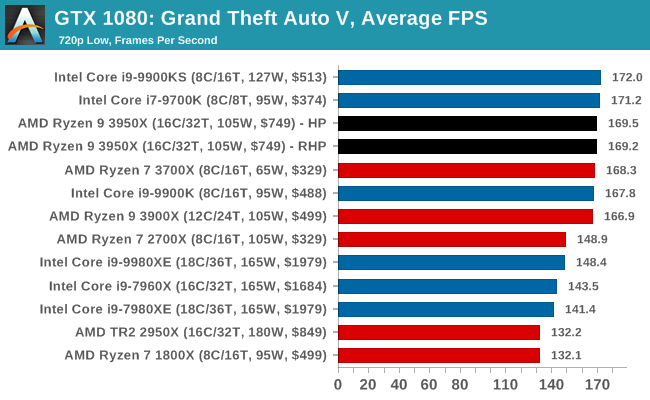 |
 |
 |
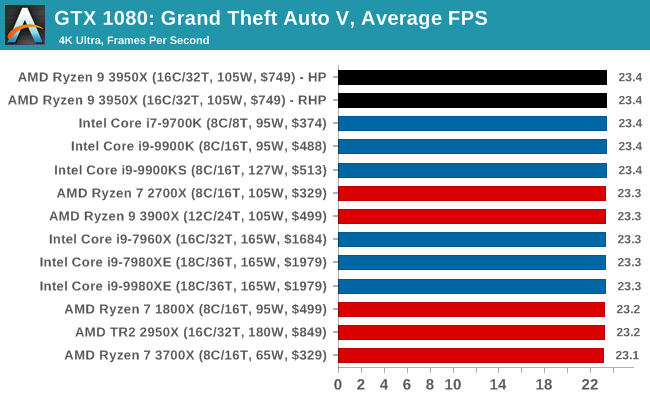 |
| 95th Percentile | 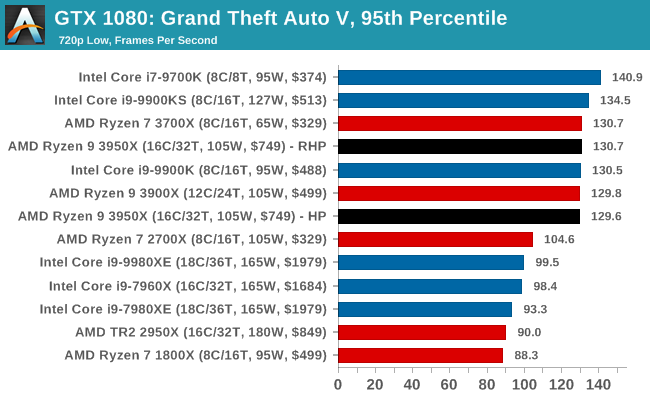 |
 |
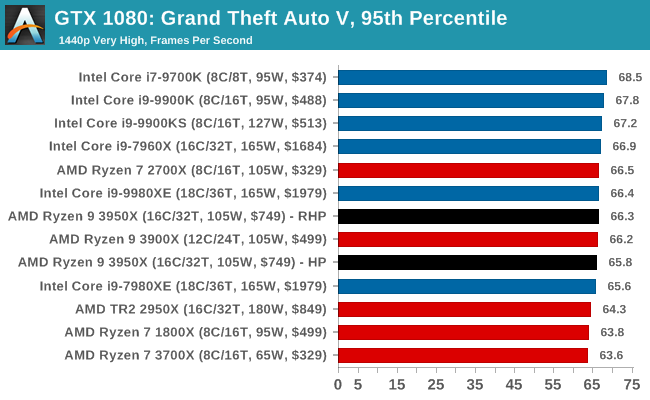 |
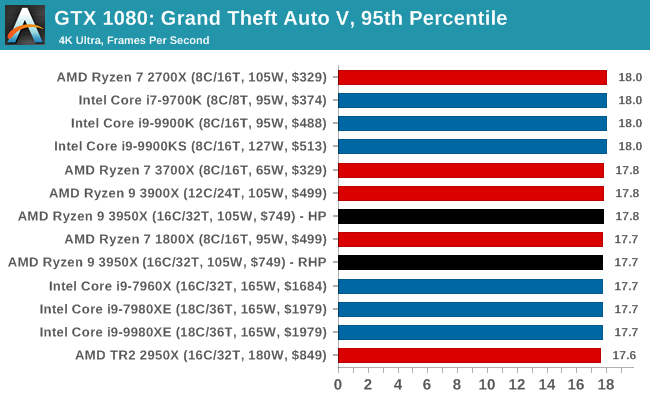 |












206 Comments
View All Comments
Netmsm - Saturday, November 16, 2019 - link
Also, in section "x264 HD 3.0: Older Transcode Test" the result of "3DPM v1 Multi-Threaded" is mistakenly placed instead of "x264 HD 3.0 Pass 2".The_Assimilator - Thursday, November 14, 2019 - link
"I’m sure some people will disagree about those 50 MHz"We call those people "whiny bitches who should STFU".
nathanddrews - Thursday, November 14, 2019 - link
In a world of such precision and technical pedants, you have to admit that it is false advertising to say 4.7GHz, when it is 50MHz shy. Rounded up, it's OK, but it's only 1% shady.For my use case, this sentence nails it perfectly: "the Core i9-9900KS is still running at 5.0 GHz for sustained single threaded work, which is still 7-15% higher than the Ryzen 3950X, and as a result it does pull out ahead in a number of ST tests as well as in low resolution (CPU-bound) gaming". Most of the games I play are not current-gen visual spectacles, but rather twitch and competitive games that are a few years old. My priority is the highest possible frame rates for high refresh gaming. I'm not sure that I do enough video editing to justify Ryzen, as tempting as the rest of the package is.
Cooe - Thursday, November 14, 2019 - link
Most every other review I've seen has it hitting the full 4.7GHz, with many even going beyond into the 4.75GHz range when adequate cooling is used. The silicon binning quality of the 3950X seems to be absolutely freaking insane. Meethinks this -50MHz deficit is unique to something specific to Ian's setup here.RSAUser - Thursday, November 14, 2019 - link
Gamersnexus also seems to have gotten a bit of a dud. LTT seems to have gotten a good one.Cooe - Thursday, November 14, 2019 - link
Not just Linus, most people have gotten "good ones". I can count the number reviews with chips that didn't reach the advertised 4.7GHz on one hand & have fingers left over to spare (and if I include all those within 50ishMHz or so, like Ian's here, it drops to just one).zmatt - Thursday, November 14, 2019 - link
Every cpu I have ever owned has always been a percent or so off the advertised frequency either above or below. The number on the box is really just an average and always has been.uefi - Thursday, November 14, 2019 - link
Don't forget, Intel has their share of the occasional performance shaving microcode patches every year or so.eek2121 - Thursday, November 14, 2019 - link
I walked away with a very different picture. Right now Anandtech is clearly GPU bound in the benchmarks. They are benchmarking on a GTX 1080, and the results clearly reflect that. Having run some of these games on a 1080ti on my stock 1950X, I get a better result. They really need a 2080ti or 2080 super at this point.plonk420 - Thursday, November 14, 2019 - link
they can't really use a 1080Ti or better with GTA5... check out GN's coverage: if you hit over ~180fps, you hit a cap that results in insane stuttering (same with RDR2 and 144hz or so)